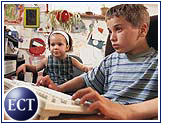Amid the unfortunate prognostications about the fate of e-commerce sites, smart marketers are setting their sites on capturing untapped markets.
Deciding which markets to tackle shouldn’t be all that difficult. After all, most e-tailers have narrowly focused their marketing efforts on the supposed “affluent, educated” population we hear so much about.
But what about the up-and-coming market, the one that promises to be more tech-savvy and computer literate than ever before? What about kids?
Littlest Big Spenders
According to studies conducted by Harris Interactive in conjunction with Nickelodeon Online, KidPulse and MTV kids and young adults age eight to 24 arespending as much as US$164 billion online, a whopping figure considering that only a small percentage of e-commerce marketing is directed toward them.
This figure is especially significant considering that a large number of American families do not yet own a personal computer.
The same study indicates younger buyers are most interested in online purchases of music, video games, books and clothes. Kids are buying items that suit their lifestyles.
For an industry desperately trying to inject itself into the everyday lives of everyday consumers, now may be the ideal time for e-commerce to set its sites on the first generation of Americans raised with Internet technology.
Digital Santa
If the most recent holiday season is any indication of kids’ buying habits, things are looking up for the e-tail world.
As was originally the case with all of e-commerce, it appears males are dropping more cash online than females, among shoppers age 18 to 21. Young men spent 18 percent of their holiday dollars online, while young women spent about 7 percent.
The trend is noteworthy especially since the Internet has been a commercially viable shopping place for less than a decade. Some younger shoppers were not even born when e-commerce began.
Just as the first generation of television kids easily adopted that medium as part of its lifestyle, the first set of e-commerce kids could do the same, if they are carefully nurtured.
Responsible Marketing
Much of the emphasis on online kids, to date, has been about protecting them from indecent material and restricting their access to unsuitable sites.
Exclusive emphasis on these efforts could backfire for two reasons. First, it sets a negative tone for kids, telling them that they’re too young to really use the Internet. Second, it fails to teach kids about the commercial viability of the online marketplace.
Now is the time to strengthen the image of online shopping among young people, and to teach them how to participate responsibly in the new economy.
Safe-Spending Zones
A couple of ventures have attempted this by controlling access and spending online tolimit how much kids could spend. InternetCash.com, like the now defunct ICanBuy.com before it, has tried to simulate a real shopping experience with pre-set dollar limitations that young shoppers can use in increments online.
Others have struck similar bargains with kids. Rocketcash.com and Doughnet.com both require young shoppers or their parents to deposit cash in advance for the privilege of shopping online.
Borrowing Dad’s Mouse
These sites are already exercising some level of responsible marketing by indirectly requiring kids to involve their parents in the online experience.
Some of the sites require users to send a check or offer a credit card in advance to establish their spending account. Not many 8-year-olds have checking accounts, so clearly the parents must participate.
A study by NFO Interactive last year found 52 percent of children have asked their parents to purchase products they have found on the Web.
Therefore, kids’ online shopping experience can become a family decision and illustrates the importance of parental guidance in developing online shopping skills.
Window of Opportunity
Jupiter Research predicts that the number of kids with access to the Internet in the classroom will grow to more than 20 million by next year. The total number of children under age 18 who will have online access, at home or at school, is expected to surpass 45 million by that time.
That means this year is ground zero for teaching kids how to claim their space in the new economy and conduct themselves accordingly.
It also means that previously shortsighted e-tailers need to recognize the new generation as the possible saviors of their online dreams.
The fate of the new economy could easily rest in the arms of the under-five-feet-tall crowd.
What do you think? Let’s talk about it.![]()
Note: The opinions expressed by our columnists are their own and do not necessarily reflect the views of the E-Commerce Times or its management.























































Social Media
See all Social Media